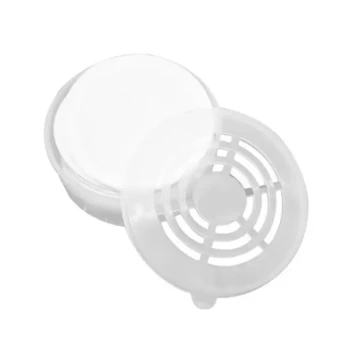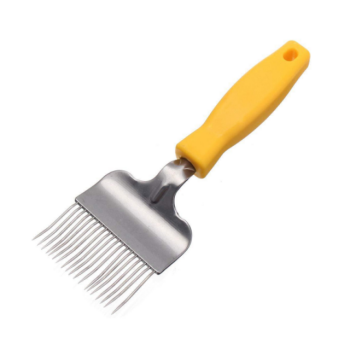To properly wear a beekeeping suit for maximum protection, you must create a completely sealed system. This involves tucking in your base layer of clothing, ensuring every zipper is fully closed, and using the built-in elastic bands to tightly seal the suit around your wrists and ankles, leaving absolutely no gaps for bees to enter.
The effectiveness of a beekeeping suit is not just in the material, but in the meticulous process of wearing it. True protection comes from eliminating every potential entry point, turning the suit, gloves, and boots into a single, impenetrable barrier.

The Principle of a Sealed System
A beekeeping suit's primary function is to serve as a physical barrier. However, bees are experts at finding small openings. Your goal is to create a sealed environment from your neck to your toes, which requires a systematic approach.
Start with a Solid Foundation
Before you even put on the suit, tuck your base layer of clothing (like a long-sleeved shirt) into your pants. This prevents your shirt from riding up under the suit and creating a potential gap at your waist.
Conduct a Pre-Wear Inspection
Always inspect your suit for any holes or tears before you head to the hives. A small rip can compromise the entire suit's integrity. Repair any damage immediately to ensure it provides reliable protection.
Secure All Primary Entry Points
When you put the suit on, be methodical. Pull all zippers completely to the end of their tracks, especially around the hooded veil where different zippers often meet. Ensure there are no gaps or misaligned teeth.
Seal the Wrists and Ankles
Your wrists and ankles are the most common points of failure. Pull your beekeeping gloves on over the sleeves of your suit. Likewise, pull the leg openings of the suit down over your boots. Use the suit's elastic cuffs to create a tight seal in both areas.
Why a Full Suit is the Standard
For beekeepers prioritizing safety, especially those who are new or uncertain about bee sting allergies, a full-body suit is the superior choice.
Eliminating the Waistline Gap
The single greatest advantage of a one-piece suit over a jacket-and-pants combination is the elimination of a gap at the waist. This is a common area where bees can gain access, and a full suit removes that risk entirely.
Building Beekeeper Confidence
Feeling fully protected allows a beekeeper, particularly a novice, to remain calm and move deliberately around the hive. This relaxation leads to better beekeeping practices and a more positive experience.
Protection Beyond Stings
A full suit also offers excellent protection from the sun during long hours outdoors. Additionally, it keeps your regular clothes clean from sticky propolis and wax that are an inevitable part of hive inspections.
Understanding the Trade-offs
While a full suit offers unparalleled protection, it's essential to be aware of its limitations and the responsibilities that come with wearing it.
The Challenge of Heat
The primary drawback of most beekeeping suits is low ventilation. On hot, sunny days, the inside of a suit can become extremely uncomfortable and lead to overheating. Ventilated, triple-mesh suits can help, but staying hydrated is critical.
The Risk of Overconfidence
The sense of invulnerability a suit provides can sometimes lead to carelessness. Remember that the suit is a tool, not a substitute for gentle, respectful beekeeping practices. Always move slowly and deliberately.
Maintenance is Non-Negotiable
A suit is only as good as its condition. Regular inspection and prompt repair of any damage are essential for maintaining its protective qualities. A torn suit provides a false sense of security and is a significant liability.
Making the Right Choice for Your Goal
Your approach to wearing and choosing a suit should align with your primary objective as a beekeeper.
- If your primary focus is maximum safety and confidence: Choose a full-body suit and be meticulous about sealing every opening at the wrists, ankles, and neck every single time.
- If your primary focus is comfort in a hot climate: Invest in a high-quality ventilated or air mesh suit, but never compromise on the process of sealing it properly.
- If your primary focus is long-term, reliable use: Always inspect your suit for holes before use and learn to make basic repairs to ensure its integrity season after season.
Ultimately, proper use of your protective gear frees you to focus on the health and well-being of your bees.
Summary Table:
| Key Step | Purpose | Action Required |
|---|---|---|
| Foundation | Prevent waist gap | Tuck base layer shirt into pants |
| Inspection | Ensure suit integrity | Check for holes/tears before use |
| Zipper Sealing | Close main entry points | Pull all zippers completely closed |
| Cuff Sealing | Secure wrists & ankles | Pull gloves over sleeves, suit legs over boots |
| Suit Type | Maximize protection | Choose a full-body suit to eliminate waist gap |
Protect your apiary operations with confidence. At HONESTBEE, we supply durable, professional-grade beekeeping suits and equipment designed for the rigorous demands of commercial apiaries and distributors. Our wholesale-focused operations ensure you get the reliable protection you need to work safely and efficiently. Contact our team today to discuss your bulk equipment needs and secure your beekeepers with the best gear.
Visual Guide

Related Products
- Wholesales Dadant Size Wooden Bee Hives for Beekeeping
- Yellow Plastic Bucket Pail Perch for Beekeeping
- Long Langstroth Style Horizontal Top Bar Hive for Wholesale
- Professional Insulated Plastic Bee Hives
- Professional Insulated Winter Hive Wrap for Beekeeping
People Also Ask
- What should you do if you find an ant nest near your beehive? Essential Strategies for Hive Protection
- What are the essential pieces of equipment for most beekeepers? Get Started with the Right Gear
- What are the characteristics of oil-based paint for beehives? Durability vs. Modern Practicality
- How often should the area under beehives be inspected and cleaned during the warm season? A Proactive Maintenance Guide
- Why were wooden hives traditionally preferred? For Natural Beekeeping Aligned with Bee Biology



















